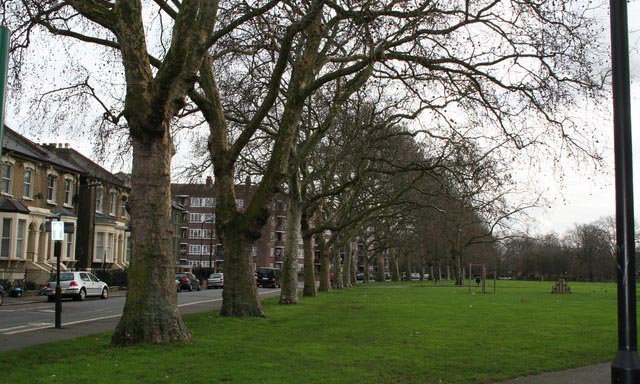Hackney in UK’s bottom five for pollution purged by trees

Green Space: plane trees along Gascoyne Road, Well Street Common, South Hackney. Photograph: Neil Clifton.
Hackney is one of the worst-performing regions in the country at removing pollution through its trees, a recent study reveals.
According to figures from the Office for National Statistics (ONS), the borough’s rate of removing air pollutants via vegetation comes joint-fourth lowest with Newham for the entire UK, at 9kg per hectare.
Four out of the five lowest-performing areas in the ONS figures were London boroughs.
Coming in below Hackney are Hammersmith, Fulham, Kensington & Chelsea and Tower Hamlets, with Lambeth occupying the bottom spot with a rate of 5kg per hectare removed.
Cllr Feryal Demirci, Hackney’s deputy mayor and cabinet member for health, social care, transport and parks, said: “Trees provide clean air for us to breathe and homes for birds and wildlife. Helping to cool the streets, combat the ill effects of climate change and make our streets and borough greener places for future generations.
“The council is committed to planting an additional 1,000 trees alongside proposals that better connect our green spaces to each other, and to the wider public realm, creating parks without borders as well as developing a Public Realm Green Infrastructure Plan.”
Cllr Demirci also stated Hackney’s commitment to increasing green canopy coverage of council-owned public spaces from 18.5 per cent to 25 per cent by 2025 as part of the 2015 Liveable Neighbourhoods plan.
The council has not set aside any specific proportion of its budget for tree-planting, and the commitment for another 1,000 trees for the borough over the next four years will be delivered as part of other projects.
A Town Hall spokesperson said: “The council is committed to planting at least an additional 1000 trees over the next four years and these will be incorporated as essential components of other schemes and developments and as an integral part of other more general budgets.”
The figures, which derive from 2015, cover a range of different air pollutants. Most harmful is PM2.5, fine particles with 3 per cent of the diameter of a human hair, but also covered are PM10, nitrogen oxide, ground-level ozone, ammonia and sulphur dioxide.
PM2.5 is mostly emitted by diesel and petrol cars, power plants and domestic heating. It can stay in the air longer than other pollutants, and can trigger asthma, heart disease, bronchitis, and other respiratory problems.
The study, published on 30 July, was produced for the ONS’ Natural Capital accounts by the Centre for Ecology and Hydrology.
It looked at the contribution to clean air made by vegetation, as well as the avoided costs in health damage from air pollutant removal.
It states that an estimated 1.4bn kg of air pollutants were removed by woodlands, plants, grasslands and other vegetation in 2015. However, over five times as much PM2.5 was emitted in the UK that year than was removed.
